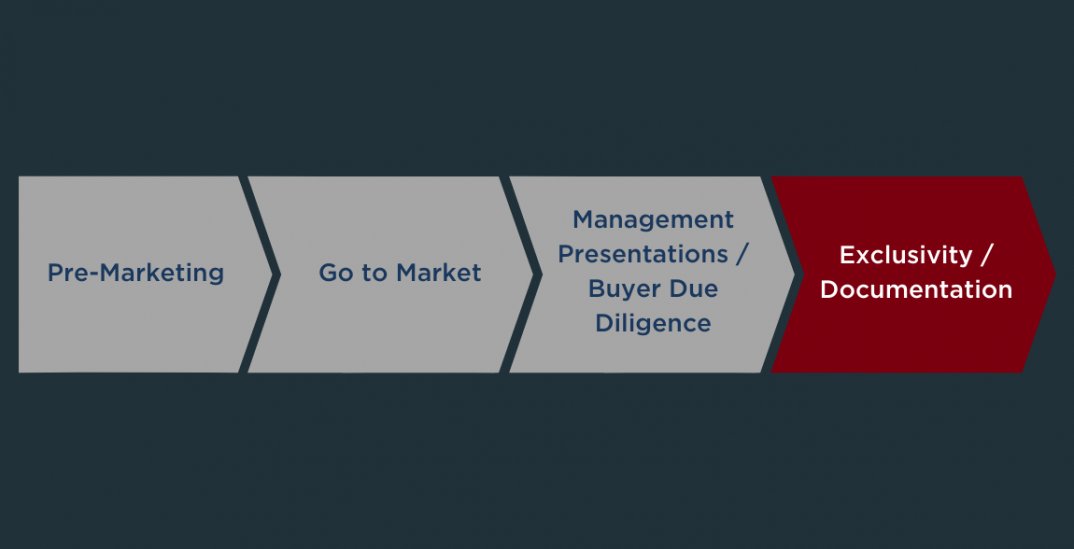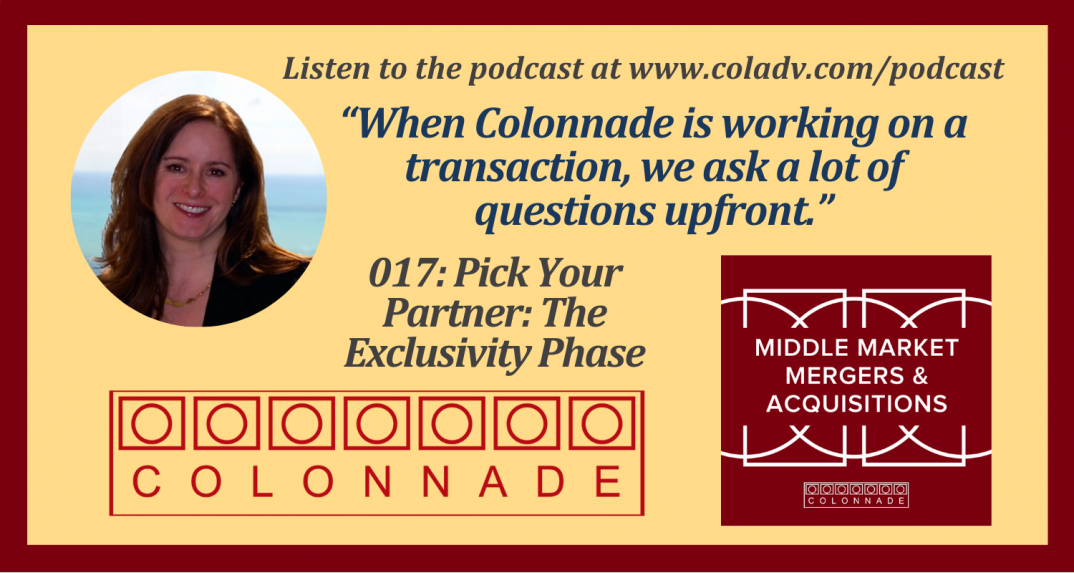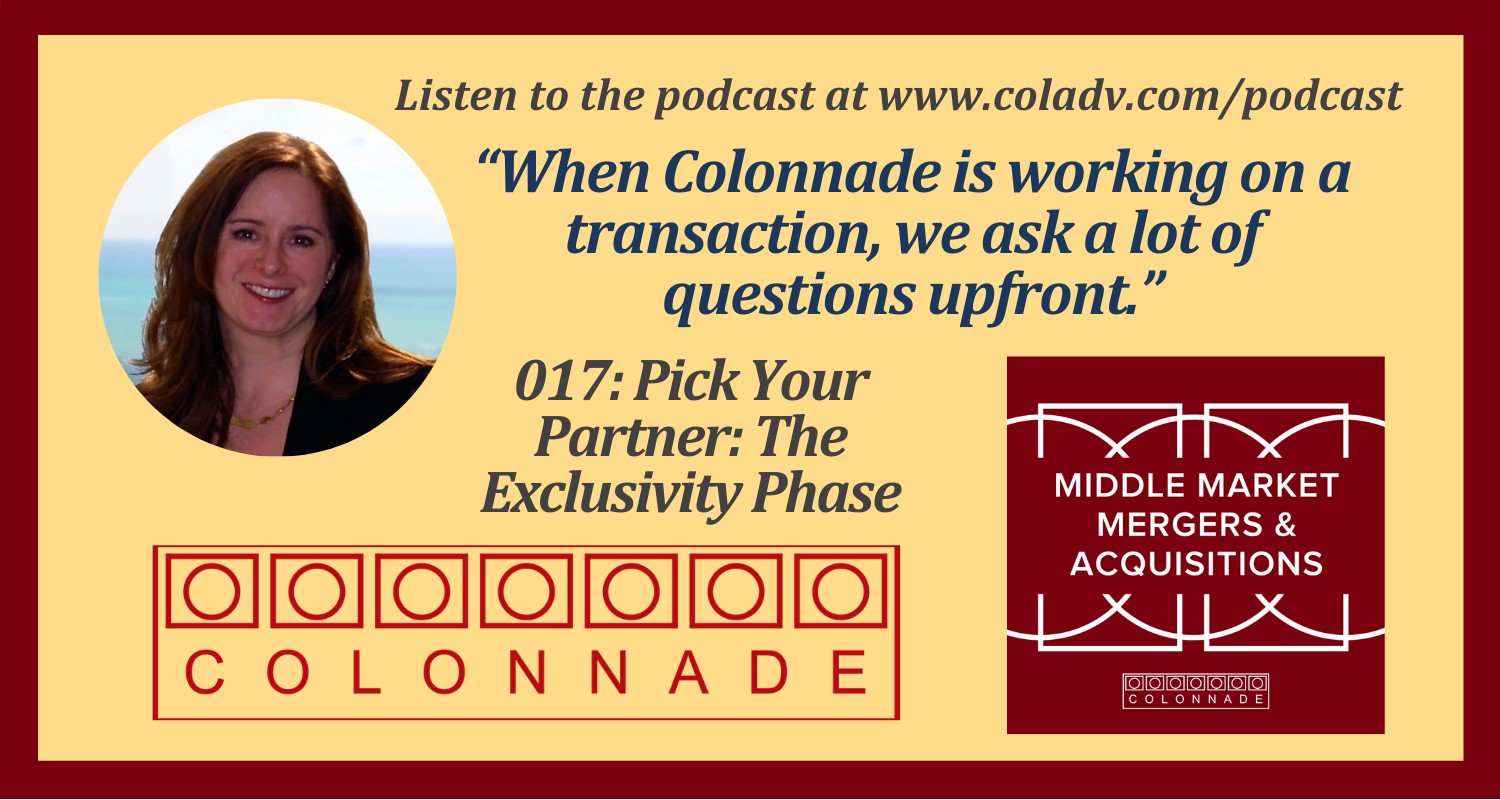We are excited to focus today’s episode on the final phase of our unique 16-week sales process.
Today we are focused on phase four: exclusivity/documentation.

We invite you to listen to episode 001 for more information about phase one (pre-marketing), episode 002 for more information about phase two (go to market), and episode 0016 for more information about management meetings.
Other episodes dive deep into technical aspects and tactics used in middle market and mergers and acquisitions. We also invite you to download our 16-week sales process timeline for more information on how Colonnade Advisors typically approaches the process of selling a company.
In our deep-dive discussion on exclusivity/documentation, the word “scary” comes up quite a few times. Rather than being scary from a horror film or haunted house, this scary is more like cold feet before a wedding.
That’s because exclusivity/documentation is when you pick your partner and take a leap of faith with a single buyer.
You’ll learn that in this phase of the sales process, we are not yet on the homestretch. In fact, our discussion unveils the many challenges of this phase of the sales process that must be simultaneously and actively managed.
You’ll hear that this phase of the sales process almost feels like a crescendo.
Our job at Colonnade is to manage this increasing set of workstreams and pull off a successfully closed deal. Then, as you’ll hear in the podcast episode, it’s time to celebrate.
Key topics covered in this episode:
- Preparing for the shift of power from seller to buyer
- The importance of the letter of intent (“LOI”) negotiations
- How to select the winner (while keeping others warm in the background)
- Who’s involved during the exclusivity/documentation phase
- How long the process takes, and how much it costs
- Pitfalls that we have encountered during this phase and how Colonnade mitigates these risks with our clients

What is the exclusivity and documentation phase, and how do you get up to this point? (01:07)
Gina: “This phase occurs when a seller is exclusive with a single buyer—we have received several bids and determined the winner. Both parties sign an LOI at this phase, and the seller agrees not to provide information or engage with any other potential buyers. The seller is essentially going off the market, which can be a bit scary because if the deal does not move forward with the exclusive buyer for some reason, then we will have to go back to the other bidders.”
What tasks need to be completed during the exclusivity and documentation phase? (02:11)
Gina: “During exclusivity and documentation phase, we work through the confirmatory due diligence, which often involves a buy-side quality of earnings report. Also, during this period, we negotiate, finalize and execute the definitive purchase agreements and work through any related regulatory tasks to close.”
Is it possible for sellers to go through the exclusivity and documentation phase with multiple potential buyers? (03:18)
Jeff: “In large transactions, it is possible to run multiple parties through this phase, but it typically does not happen in middle market deals.”
What is the importance of the letter of intent (LOI) negotiations? (04:13)
Jeff: “LOI negotiation is critical because we want to nail down all the topics that we think are going to be critical in negotiation and final documentation before we commit to one party. Hammering out these key topics ahead of time also expedites the process.”
Is the highest price generally selected as the winner? (05:05)
Jeff: “Business owners do not always pick the highest price. It is also about picking the best terms.”
Listen to Colonnade’s podcast episode 007: Striking a Deal: Price & Terms.
Once a seller is exclusive with a buyer, is there a backup plan if the deal falls apart? (05:15)
Jeff: “We keep the non-winning bidders warm and engaged in a limited fashion to make sure that we have backups if the deal falls apart.”

How do you assess the certainty to close a deal? (06:30)
Jeff: “Assessing the certainty to close comes from years of experience working with buyers and thinking through key items such as where is the capital coming from, what their acquisition history is and how likely they are to close on the terms that we have outlined.”
Are there particular buyer types that are more problematic in terms of the certainty to close? (06:35)
Gina: “One group that has caused us problems with the certainty of close in the past is search funds or unfunded sponsors, which are private equity investors that do not have a dedicated fund. These funds tend to bid the highest prices, which is appealing, but they will still need to raise the capital once in exclusivity from institutional investors. Those institutional investors will want to do their diligence, almost restarting the deal process, which creates more risk of the deal not getting done.”
Jeff: “About ten years ago, family offices were also in this category to some degree. Family offices had smaller dedicated investment teams, so the certainty of closing was considerably lower than traditional private equity firms or a strategic buyer. But that has changed over the last decade where family offices have shifted to become credible buyers.”
How long does it take to get from signing the LOI to closing? (08:45)
Gina: “We generally put 30 to 45 days in the LOI with a provision that both parties can extend the period of exclusivity by mutual written consent based on putting forth best efforts. The time to close depends on the industry. For example, some industries may need regulatory approval or use complex accounting methodologies, which would require more time.”
What are the components of confirmatory diligence, and how are these workstreams sequenced? (10:06)
Jeff: “There is HR, accounting tax compliance, regulatory, legal, IT, and others. Running these workstreams in parallel is key because it is the easiest way to minimize time to close, but you cannot get to the legal documentation until all these other workstreams are completed.”
At what point do you expect the first turn of the purchase agreement from the buyer? (12:30)
Gina: “Pushing to get that first turn of the purchase agreement is very important. We frequently put the purchase agreement in the data room before the LOI, and we expect a markup of it along with the LOI or an issues list, which will help expedite the process.”
Who pays for the costs associated with confirmatory diligence and documentation? (13:38)
Gina: “The seller pays for the seller’s costs, and the buyers pay for the buyer’s cost.”
Jeff: “In the context of a rollover deal, where the company is getting bought by a sponsor, the surviving entity ends up absorbing costs from both sides.”
What are the typical costs incurred during this phase for sellers and buyers? (14:31)
Gina: “The seller can expect to pay for tax counsel or tax accountants if there is tax work to be done, an attorney to assist with negotiating terms, a tax lawyer, and other types of counsels. Buyers can expect to encounter legal fees, accounting fees, consulting fees, IT, technology consulting, and HR consulting.”
How much does this phase cost for both the sellers and buyers? (14:31)
Gina: “Ballpark is anywhere from $75,000 to a couple hundred thousand for a seller. On the buyer’s side, a couple hundred thousand easily on diligence for a middle market transaction that’s valued $75 to $125 million.”
From the seller’s side, who is typically involved during the confirmatory diligence phase? (15:55)
Gina: “Confirmatory diligence is a big undertaking, and sometimes the knowledge level about the company needs to go beyond the deal team that has been involved to date. At this stage, other people in the company may need to be made aware of the transaction (e.g. sales management, IT, HR, etc.), which can be tricky.”
What types of issues generally come up in employment contract discussions? (18:57)
Gina: “One issue that comes up is pay, which we manage by building out expected compensation levels in the financial model. The second issue is the bonus structure, and the third is vacation. The most important issue that comes up is non-compete, who gets one and what the terms are.”
Which employees will generally be subject to non-competes? (19:25)
Jeff: “There is usually a non-compete for selling shareholders that will be getting proceeds from the deal and non-equity participants that are key to the ongoing entity.”

What are the risks associated with employment agreements and non-competes, and how do you mitigate these risks? (20:52)
Jeff: “The risk with non-equity participants that are key to the business is that they could choose not to go with the new buyer for whatever reason. This can result in a domino effect from a price change to the deal not happening at all. One tactic that we use is to encourage our seller clients to put in place some type of transaction and retention bonus.”
Gina: “When Colonnade is working on a transaction, we ask a lot of questions upfront. We will often ask who has employment agreements and what are the terms of those agreements. For business owners that are thinking about selling in a few years, they should be thinking about who their key employees are and how to get them under employment agreements now.”
What are the different types of employee bonus plans associated with a sale? (23:17)
Jeff: “One is transaction bonuses which are for employees who are essentially doing two jobs during the deal process. The second is the retention bonuses that ensure employees are not going to leave when the deal closes.”
What is Hart Scott Rodino (“HSR”), and how does it impact the transaction? (23:59)
Gina: “HSR is one type of regulatory approval that might be needed to close a deal. HSR applies to companies of a certain size, which will need to be approved by the government for anti-trust reasons.”
Jeff: “The amount increases every year, but HSR impacts transactions roughly around $80 million in transaction value. There is a filing fee, and it is about a 30-day process.”
How long does it typically take from signing the legal documents to closing? Who owns the company during this period? (26:13)
Jeff: “It can be 30 days or longer, depending on the different types of approvals. For financial services deals where there is generally regulatory approval, it is often 30 or 60 days. During this period, the seller and buyer essentially both own the company.”
Can sellers request a break fee if the deal does not close? (27:00)
Gina: “In highly competitive, larger transactions, there will be break fees, but in middle market M&A, it’s highly unusual to have a break fee. That is because there is not enough diligence that has been done before the signing of the LOI. Without all the information, it is unlikely that buyers will agree to a break fee because they may find out many things during confirmatory diligence.”

What are typical pitfalls encountered during the exclusivity/documentation phase? How does Colonnade mitigate these risks with seller clients? (28:58)
Gina: “One is indemnification, which reps and warranties insurance can mitigate.”
Listen to Colonnade’s podcast episode 010: Escaping escrow: Reps & Warranty Insurance.
Jeff: “Another pitfall that we have seen involves who owns the intellectual property. To mitigate this risk, we address this issue early in diligence.”
Gina: “Another is when the buyers want to speak with the seller company’s top clients. We try to delay that conversation until as late as possible in the process. We want to get to the point where we feel comfortable that we have covered all the major issues, and we’re likely to close.” Jeff: “The last pitfall that comes to mind is tax, where two parties can have a different view on tax regulations in a given jurisdiction. Our job is to push things forward and cut through all the issues as quickly and efficiently as we can.”
What dynamics are typically in play right before a deal closes? (39:02)
Jeff: “What I find is when people are the angriest and they’re about to throw up their hands, that’s when we know we’ve got a deal, it’s sort of where everyone’s been pushed to their limits. Everyone’s had to give and take, and they’re just about ready to walk away, and then the deal signs.”
Gina: “And then we celebrate.”






